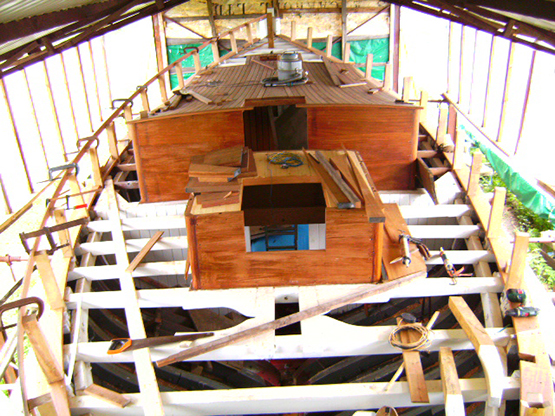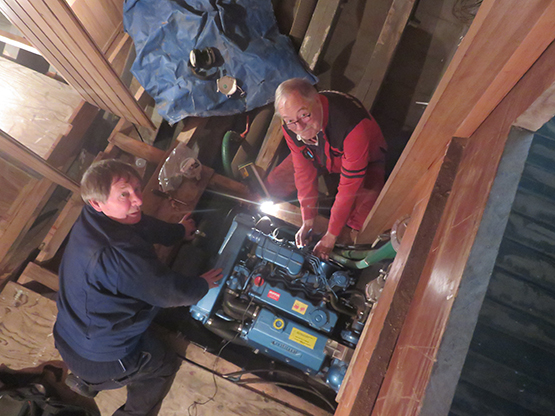Displaying items by tag: Conor O'Brien
The Baltimore Wooden Boat Festival 2017 from Friday 26th to Sunday 28th May will feature a remarkable selection of old, restored and new craft - traditional and classic alike - all reflecting the many aspects of the arts and crafts of the boatwright and shipwright writes W M Nixon.
The hospitable setting is highly appropriate, as there are more skilled boatbuilders beavering away in hidden workshops in West Cork than in any other comparable part of Ireland. And a few miles upriver from Baltimore on the River Ilen (which in due course brings you to the Olympic Medal-winning Skibbereen Rowing Club), you’ll find the boatyards of Oldcourt, where among other projects, Liam Hegarty and his craftsmen are bringing the restoration of the 1927-built ketch Ilen of Conor O’Brien fame to completion.
It’s the Ilen which provides a link to a notable debut at Baltimore by a new small boat in three weeks’ time. With both his world-girdling 40ft Saoirse of 1923, and the 57ft trading ketch Ilen which he delivered to her satisfied customers in the Falkland Islands, O’Brien felt that a robust and stable 10ft dinghy – or punt as he would have called it – provided all that he needed in the way of a ship’s tender.
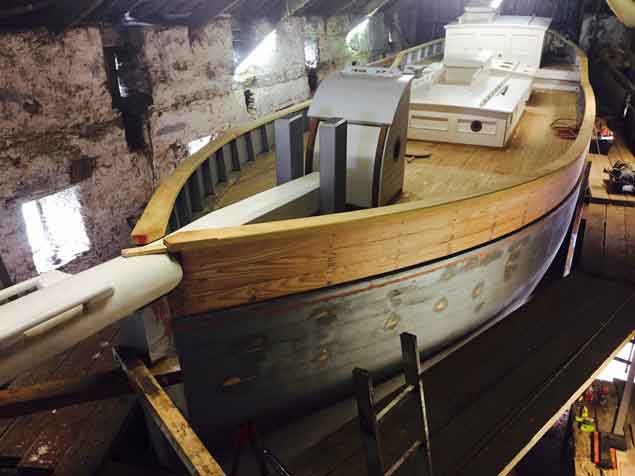 Progress continues on the restoration of Ilen. All the deckhouses - built in the Ilen Boatbuilding School in Limerick – have now been installed in the ship herself at Oldcourt near Baltimore. Photo Gary MacMahon
Progress continues on the restoration of Ilen. All the deckhouses - built in the Ilen Boatbuilding School in Limerick – have now been installed in the ship herself at Oldcourt near Baltimore. Photo Gary MacMahon
He wasn’t alone in this view. At the same time in 1926 on Cork Harbour, John Valentine Sisk, owner of the substantial motor-launch Culleann, ordered a new 10ft punt for use as Culleann’s tender from noted Passage West boatbuilder Pierce Power. Cullean already had a 10ft punt, but it was considered too unstable. So Pierce Power faced the considerable challenge of creating a boat only 10ft long with firm midships sections for stability, yet with bow and stern artfully shaped to retain her predecessor’s ease of rowing.
He succeeded brilliantly, so much so that the Sisk family kept the punt after Cullean had moved on. Before John Valentine Sisk’s death in 1957, his three grandsons George, Hal and John had learned to row in this very special little boat. Then with his son John G Sisk now moved to Dublin, the Valentine Punt followed to be the tender to his Dun Laoghaire-based yachts Marian Maid, Stern and Sarnia until 1970.
She then went to a son-in-law Schull, and eventually was bought by fishermen on Long Island, where her yacht-style varnish was painted over, and finally tarred. She was reckoned past her working days when Hal Sisk found this fondly-remembered boat of his childhood and youth on the island, and had her restored. In time, she became part of the collection in the National Maritime Museum in Dun Laoghaire as representative of a type once found at every yacht and fishing harbour on Ireland’s south coast, and many other ports and anchorages elsewhere.
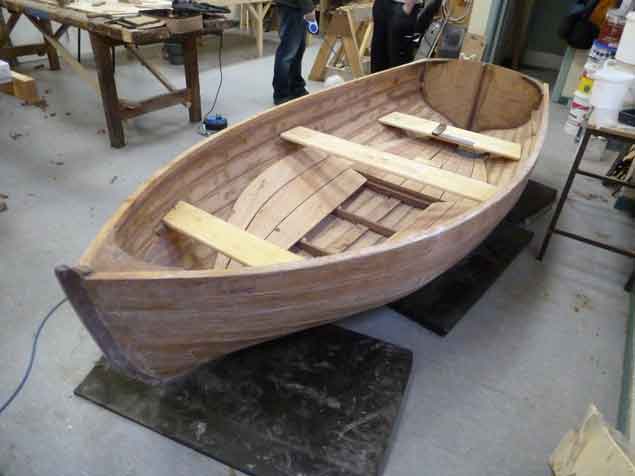 The Valentine Punt with the aft thwart removed to show the carefully-calculated shape of the transom – when afloat, it will offer minimum drag while helping when necessary with the hull form’s inherent stability.
The Valentine Punt with the aft thwart removed to show the carefully-calculated shape of the transom – when afloat, it will offer minimum drag while helping when necessary with the hull form’s inherent stability.
However, it was the ease of rowing the Valentine Punt which was the fondest memory, so the late Michael Tyrrell of Arklow took off her lines for Hal Sisk with a re-creation in mind. But it was reckoned that real benefit would be conferred if the lines could be used, yet instead of the inevitably heavy traditional clinker construction with ribs (timbers), much lighter construction could be achieved by building instead with glued clinker ply.
Alec Jordan in Scotland is an acknowledged expert in creating laser cut marine ply kits, which are then built into a boat with the “lands” of the lapstrake planks now bonded and sealed with impervious gap-filling epoxy resin. The result of this project was an elegant hyper-light and easily-rowed yet stable 10ft punt which has been the ideal tender for Hal Sisk’s classic cutter Peggy Bawn and his innovative motor-cruiser Molly Bawn.
The Valentine Punt is a concept which could have many uses, and when the notion of having one as the tender to the restored Ilen came up, the Ilen Boatbuilding School director Gary MacMahon in Limerick leapt at the chance, as the school is always enthusiastic about testing new methods of wooden boatbuilding to broaden its syllabus.
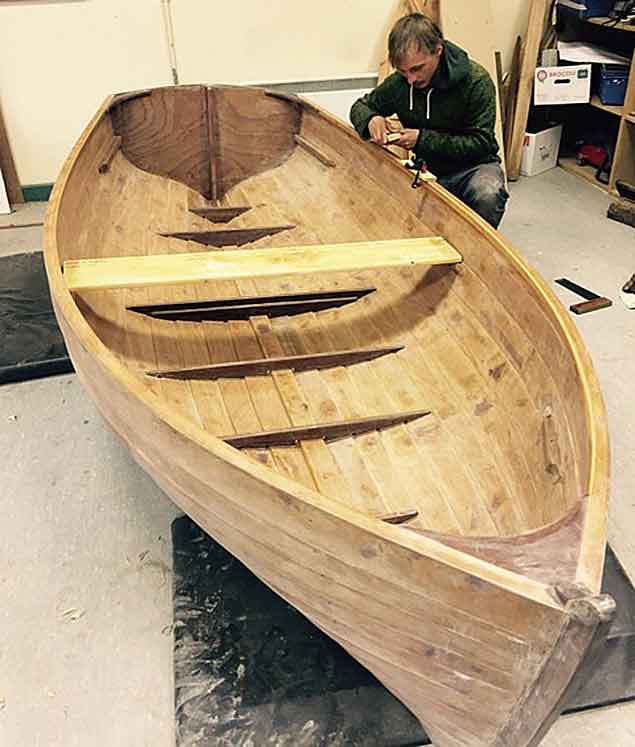 Elan Broadley at work on his special creation, the latest Valentine punt developed from a proven design which is now 91 years old. Photo: Gary MacMahon
Elan Broadley at work on his special creation, the latest Valentine punt developed from a proven design which is now 91 years old. Photo: Gary MacMahon
This latest model of the Valentine Punt has been built in the school by Elan Broadley, a trainee boatbuilder from Donegal, and he and his attractive creation will be making their debut in Baltimore during the Wooden Boat Festival, with a bit of a party involving all the main players, and his mum down from Donegal. After that, the little boat won’t have far to go to be united with her mother ship, the Ilen herself, preparing for launching at Oldcourt.
Christmas Dreams Of Irish Wooden Boats – Old & New, Real & Fantasy
The season is upon us for goodwill and dreams of very special gifts. And for many Irish sailors, the dream Christmas present would be an elegantly classic or solidly traditional wooden boat, with all maintenance and running costs somehow covered by Divine Providence into infinity……W M Nixon goes down the Yuletide timber trail.
Love of wood is part of what we are. It’s in our genes. At some times and some places in the remote past, an instinctive fondness for wood, and an inherited ability to do something useful with it, would make all the difference between survival and extinction. So though today the availability of other more purposeful materials may have transformed boat-building, a new boat without some sort of wood trim is a very rare thing indeed.
At a more personal level, many of today’s generation of sailors cherish family memories of the communal building of wooden DIY kit boats at home. Here, there and everywhere, a drawing room or little-used dining room found itself a useful new purpose as a boat-building salon, with Mirror dinghies and occasionally larger craft taking shape in domestic settings throughout the land.
“Our daddy the boat-builder” became a household name in his own household. And for those who sometimes wonder why today’s adult sailors can become misty-eyed at the very thought of the Mirror dinghy (which really was and is a wonderful design and concept), the answer surely is that at a significant stage of their sailing and family life, a Mirror dinghy was centre stage, the symbol of a family’s shared values, hopes and interests.
But maybe the most important thing about the Mirror is that she is so eminently practical. So perhaps at Christmas we should allow our imaginations to take flight and soar high to envisage the complete wooden dreamship. And there she is as our header image, introducing this week’s meandering thoughts. That schooner at the moment is total fantasy. But any sailing enthusiast who looks at that concept design and doesn’t think: “Now there’s my dreamship”, well, he or she just doesn’t have a true sailing soul.
The origins of Eirinn, as she is named for the time being, go back to 2012, when the nascent Atlantic Youth Trust sought suggestions as to what a new sail training vessel for all Ireland should look like. But with their proposals recently getting the first real hints of a fair wind from both governments, the AYT have gone firmly down the route of a 40 metre steel barquentine.

The Ilen as she was in the Spring of 2015 in Oldcourt...
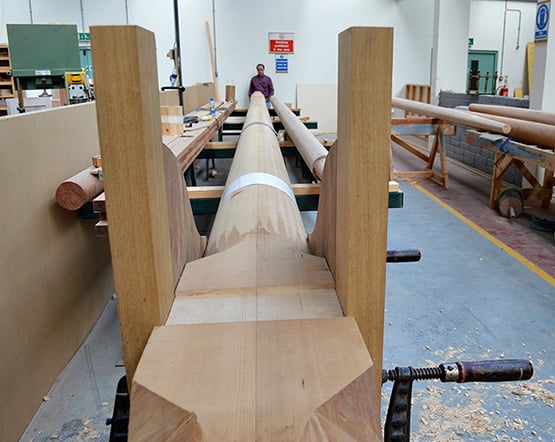 ….while in the Ilen Boatbuilding School in Limerick, spars and deckhouses were taking shape
….while in the Ilen Boatbuilding School in Limerick, spars and deckhouses were taking shape
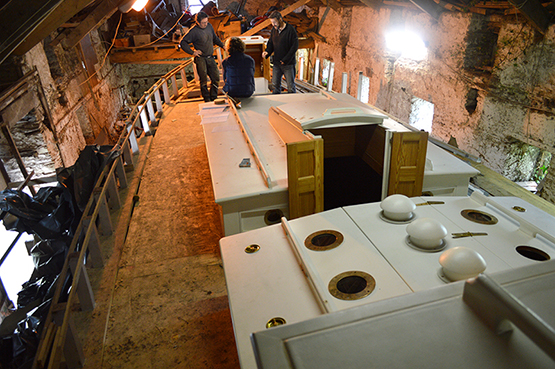
Deckhouses built in Limerick are offered up on the Ilen in Oldcourt
However, down in Limerick where they were busy with moving forward the restoration of the Conor O’Brien 1926 ketch Ilen at two sites – the hull with Liam Hegarty in Oldcourt near Baltimore in West Cork, and the deckhouses, spars and other smaller items being built at the Ilen Boat Building School in Limerick – they gave some thought in 2012 to the possible form of a new sail training vessel. They came up with the concept of a classic 70ft schooner which they knew, thanks to the work on Ilen, that they could build themselves using the skills learned and deployed in re-building the O’Brien ketch.
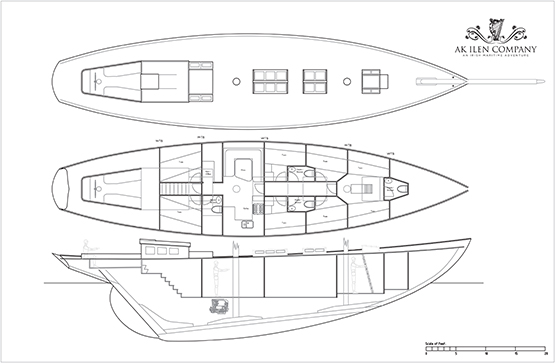
A classic hull for a classic schooner – Theo Rye’s profile and general arrangements plan for the schooner concept of 2012
But with the Ilen project moving steadily on towards the vessel’s commissioning next summer, and with other directly-related new proposals at an advanced stage in the pipeline, that sublime schooner concept is in a sort of limbo, truly a fantasy.
Yet she’s such a lovely thing that we’re happy to use her as our symbol of Christmas cheer. Her creators are Gary MacMahon of the Ilen Boatbuilding School, and Theo Rye, who is best known as a technical consultant in naval architecture, and on clarifying matters of design history and detail in boat and yacht design. But he can turn his hand to all sorts of design commissions if required. He came up with the clever concept for the CityOne dinghies in Limerick, and when Gary started musing about a classic training schooner, within the scope of what the Ilen school could do, as their answer to the AYT sail training vessel query, Theo came up with the goods and then some.
In fact, the design of the hull is so perfect that we’ll run it again right here to save you the trouble of scrolling back to the top. The overhangs at bow and stern are in harmony, but it is the sheerline which is the master-stroke. There isn’t anything you’d want to change in it, yet when you look at other famous schooners such as the fictional Southseaman (in real life she was Northern Light) in Weston Martyr’s masterpiece of maritime literature The Southseaman – the Story of a Schooner (1926), we see a sheerline which is too flat in the way of the foremast. But with Eirinn, the curve is just right, and it’s something achieved by tiny adjustments and balances which the eye can’t really perceive, yet somehow it registers the sublime harmony of the total concept.
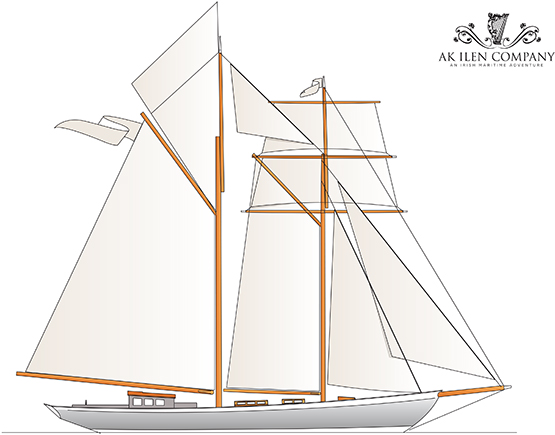
Worth a second look – and then a third one. The longer you look at the lines of Eirinn, the sweeter they seem. But her overall appearance might be improved with a slight rake of the masts
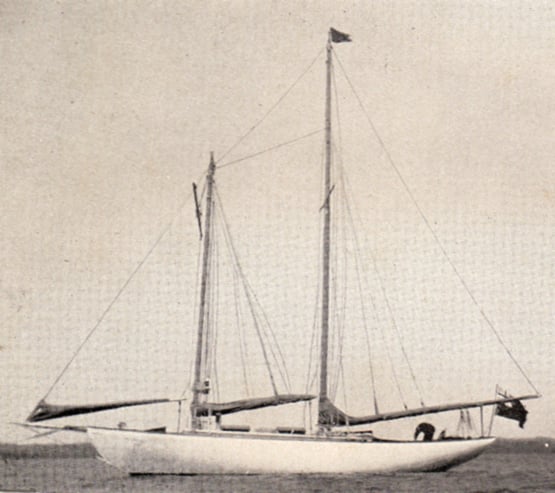 A schooner sheer not quite right – Weston Martyr’s Southseaman (aka Northern Light) could have done with a livelier sheerline abeam of the foremast.
A schooner sheer not quite right – Weston Martyr’s Southseaman (aka Northern Light) could have done with a livelier sheerline abeam of the foremast.
So Theo Rye not only writes critiques of other people’s designs, but if given the chance he can personally come up with something which is wellnigh impossible to fault. Of course, we mightn’t quite go for the same rig – a little bit of rake in the masts wouldn’t go amiss - and for private use you’d want something a little different from the dormitory layout of the training ship. But that said, this is a beautiful yet not excessively pretty-pretty hull, a boat which sings. And the fact that she’s beyond just about every private owner’s reach only adds to the mystique.
But to redress the balance, last week we’d an inspiring evening’s entertainment and information about a dreamship which really is being re-created. It was the December gathering of the Dublin Bay Old Gaffers Association in the ever-hospitable Poolbeg Y & BC, and a full house was there to hear about how Paddy Murphy of Renvyle in the far northwest of Connemara is getting on with his mission of bringing the famous Manx sailing nobby Aigh Vie back to life.
Paddy himself is something special. When asked his trade, he says he’s a blacksmith. But he can turn his hand to anything. Originally a Dub, his early sailing experiences included owning a Flying Fifteen and a Dragon, though not – so far as I know – at the same time. But then got the gaff rig traditional boat bug, and a sail on Mick Hunt’s Manx nobby Vervine Blossom sent him in pursuit of near-sister Aigh Vie. She was reportedly for sale, having for a long time been the pet family cruising boat of Billy Smyth and his family at Whiterock Boatyard on Strangford Lough, after spending her final working years fishing as a motorized vessel out of Ardglass.

Aigh Vie as she was in Whiterock Boatyard when Paddy Murphy bought her, her elegant huul shape clearly in evidence
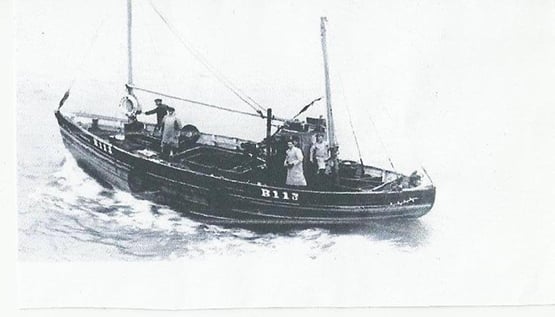 Aigh Vie in her final working days as a motorised fishing boat based at Ardglass
Aigh Vie in her final working days as a motorised fishing boat based at Ardglass
The deal was done, an ideal buy for a special man like Paddy Murphy, for the Aigh Vie is one very special vessel. The Manx fishing nobbies reached their ultimate state of development in the first twenty years of the 20th Century before steam power and then diesel engines took over. The nobby evolved to an almost yacht-like form through vessels like the 43ft White Heather (1904), which is owned and sailed under original-style dipping lug rig by Mike Clark in the Isle of Man, and the 1910 Vervine Blossom, now based in Kinvara, which was restored by Mick Hunt of Howth, but he gave her a more easily-handled gaff ketch rig which looked very well indeed when she sailed in the Vigo to Dublin Tall Ships Race in 1998.
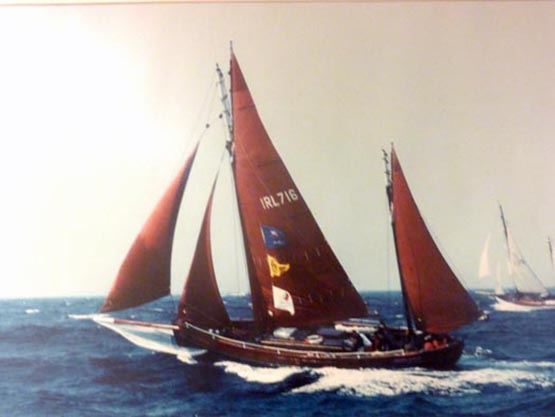
It was a sail on Mick Hunt’s 1910-built Manx nobby Vervine Blossom which inspired Paddy Murphy to go in pursuit of Aigh Vie
It takes quite something to outdo the provenance of these two fine vessels, but the story of Aigh Vie (it means a sort of mix of “good luck” and “fair winds” in Manx) is astonishing. It goes back to the sinking of the Lusitania by a German U Boat off the Cork coast in May 1915, when the first boat to mount a rescue was the Manx fishing ketch Wanderer from Peel, her crew of seven skippered by the 58-year-old William Ball.
They came upon a scene of developing carnage. Yet somehow, the little Wanderer managed to haul aboard and find space for 160 survivors, and provide them with succour and shelter as they made for port. In due course, as the enormity of the incident became clear, the achievement of the Wanderer’s crew was to be recognised with a special medal presentation. And then William Ball, who had been an employee of the Wanderer’s owner, received word that funds had been lodged with a lawyer in Peel on behalf of one of the American survivors he’d rescued. The money was to be used to underwrite the building of his own fishing boat, to be built in Peel to his personal specifications. The name of the donor has never been revealed, but the result was William Ball’s dreamship, the Aigh Vie, launched in December 1916 and first registered for fishing in January 1917.
Over the years, the Aigh Vie became a much-loved feature of the Irish Sea fishing fleet. Tim Magennis, former President of the Dublin Bay Old Gaffers Association, well remembers her from his boyhood days in the fishing port of Ardglass on the County Down coast. Her working days over, Billy Smyth gradually converted her to a Bermudan-rigged cruising ketch with a sheltering wheelhouse which enabled the Smyth family to make some notable cruises whatever the weather. His son Kenny Smyth, who now runs the boatyard with his brothers and is himself an ace helm in the local 29ft River Class, recalls that the seafaring Smyth family thought nothing of taking the Aigh Vie to the Orkneys at a time when the average Strangford Lough cruiser thought Tobermory the limit of reasonable ambitions.
After he’d bought the Aigh Vie and brought to her first base in Howth, Paddy Murphy soon realised he’d still a lot to learn about sailing and about keeping hard-worked old wooden boats in seafaring condition. But he’s such an entertaining and inspirational speaker that you’re swept along in his enthusiasm and empathise with his admission that, now and again, he felt things were getting on top of him.
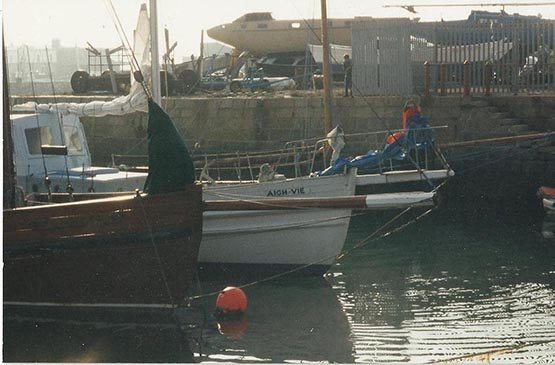
Sisters - Vervine Blossom (foreground) and Aigh Vie in Howth
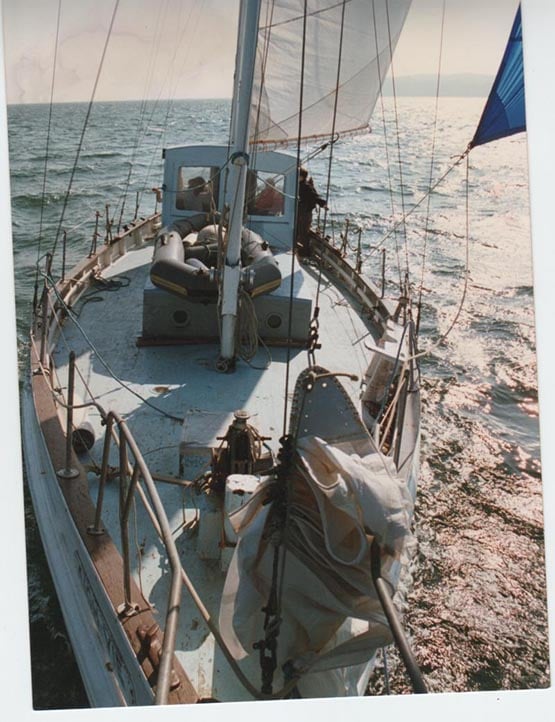
Sailing days on the Aigh Vie from Howth, before it was decided that she needed a major restoration
Following several seasons with increasing evidence of problems, he decided that a virtual re-build was necessary. It was then that the Dublin wooden boat owners’ perennial problem shot to the top of the agenda. In our very expensive city, the space and shelter to work long hours at an old wooden boats is almost impossible to come by, and he’d to shift the big Aigh Vie several times. On one occasion, he was asked to move in a hurry out of an ESB shed, but was offered £1,000 (this was pre-Euro days) to do so. He moved heaven and earth and finally found somewhere else at considerable expense, got the Aigh Vie installed there, and then went back to collect his thousand snots. Only to be laughed at. The manager told him it was the only way he could see to get the old boat moved out, but there were absolutely no funds available at all for such a thing, and surely Paddy would have guessed that?
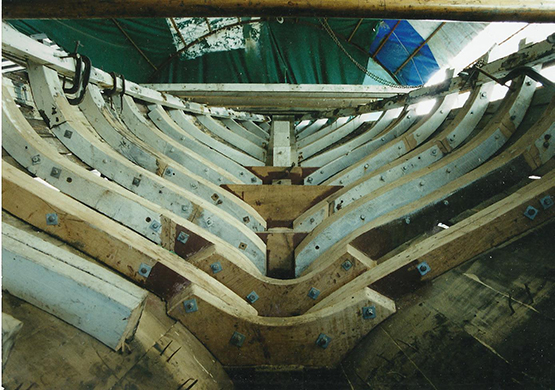
The re-building under way at Renvyle, using the technique where hull shape is retained by first replacing every other frame
With one thing and another, he moved to Renvyle in Connemara where he liked the big country and the open spaces and the friendly people right on the edge of the Atlantic, and in time Aigh Vie came too, and found herself being slowly re-born under a special roof. But it was demanding work for one man, so every so often a team led by Paul Keogh of the famous Galway Hooker from Clondalkin, the Naomh Cronan, together with a good selection of DBOGA specialist talent, descends on Renvyle to put in a ferocious day or two of work, and then on the Saturday night they put a fair bit of business the way of the pub at Tullycross.
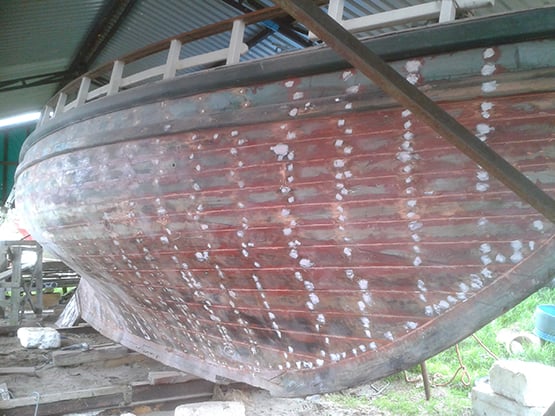
The planking was more easily restored by laying the Aigh Vie over on her side
Agh Vie upright again, and the deckhouses are being put in place
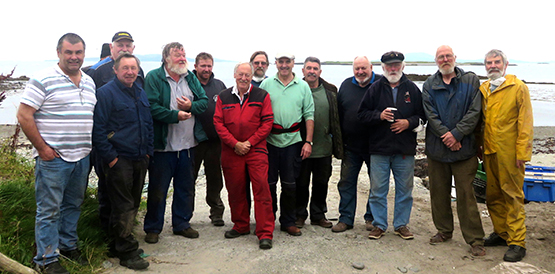
Old Gaffers Association International President Sean Walsh (right) and Peter Redmond install Aigh Vie’s new Perkins diesel. Photo: Cormac Lowth

One of the options for Aig Vie’s rig is the classic lug ketch as shown here with Mike Clark’s 1903-built White Heather
So now, many years later, the journey towards the restored Aigh Vie is getting near its destination. But it will never be fully ended. Thanks to sails, spars and rigs donated from other boats, Paddy has the choice of either gaff ketch or classic lug rig, so she’ll always be work in progress. Which is good news. Because every couple of years or so, the DBOGA can guarantee a full house to hear Paddy Murphy talking about how the Aigh Vie story is going.
He’s a wonderful speaker, sometimes almost messianic, and he shares his every feeling. Thus he mentioned that one day he was feeling a bit low, and he just went out to look at the big boat down by the shore, seeking some sort of inspiration. His mind had been elsewhere with the details of completing the interior, but he suddenly realised that he was at the stage of thinking of putting the white paint on the topsides. So he just set to with a big paint brush and a bigger tin of paint, and Aigh Vie was transformed. So was he. “That’s the secret” says he. “If you’re feeling a bit down, just go out and slap on some white paint. It works wonders.”

Feeling a bit down? Then just go out and slap a coat of white paint on the boat – it works wonders
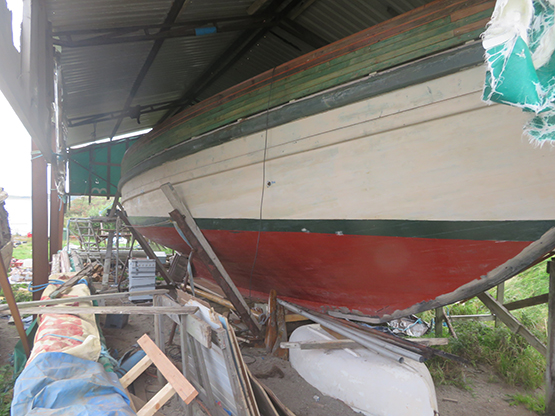
#woodenboats – In the annals of Irish seafaring, whether professional or amateur, only a very few can match the achievement of Conor O'Brien (1880-1952). Between 1923 and 1925, this multi-talented sailor from Foynes on the Shannon Estuary circled the world south of the Great Capes in the 42ft ketch Saoirse which he'd designed himself with the help of Tom Moynihan of the Baltimore Fisheries School Boatyard.
It was there that this unique vessel was built in 1922-23 as Ireland in general – and West Cork in particular – recovered from a short but brutal Civil War. The very fact that Saoirse was built in Baltimore, followed by the successful completion of her great voyage, became part of the slow post-war healing process. So as the 2015 Traditional and Classic Boat Season gets under way this weekend with the Baltimore Wooden Boat Festival, W M Nixon voices the hope that Saoirse – which had been feared totally lost since 1979 – may be re-born.
They're hardy sailors in West Cork. That lotus-land of easygoing cruising may seem a gentle place in high summer, yet down there they've felt the recent summer-delaying cold spell as sharply as anywhere else. But despite the unfavourable conditions, as usual in this last full weekend of May we'll see the Baltimore Woodenboat & Seafood Festival swing into action. And although wooden boats need reasonably good springtime weather almost as an essential for the annual refit, there'll be a colourful turnout of character vessels large and small.
But the talk of the town will not be about a boat which is showing her style off the busy Baltimore waterfront today. Indeed, not only will this very special boat not be there, but it's a moot point as to whether she still exists. Put another way: Does enough of Saoirse still exists to allow a re-creation of this wonderful little ship to be properly classified as a re-build?
The voyage of the Saoirse in 1923-1925 only gains further lustre and wonder with the passage of time. It was an achievement of greatness, yet of beautiful simplicity. It was a uniquely pioneering venture made by an Irish skipper in an Irish designed-and-built vessel, and it was the first major voyage by an Irish ship of any size flying the Tricolour ensign of the new-born nation.
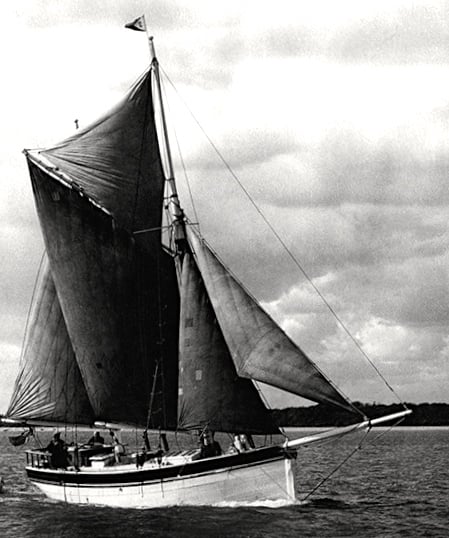
Saoirse under her original ketch rig in the 1950s, but with a boom fitted to the mainsail. Conor O'Brien had a loose-footed mainsail, and as evidenced here, the sail would have set much better but would have needed more attention in handling. (From a photo by Eric Hiscock)

In dry dock during the 1950s, Saoirse's "cod's head & mackerel tail" hull shape is clearly seen. Yet in the Great Southern Ocean on her voyage round the world south of the Great Capes, this bluff little 42ft ketch regularly logged 180 miles a day in comfort.
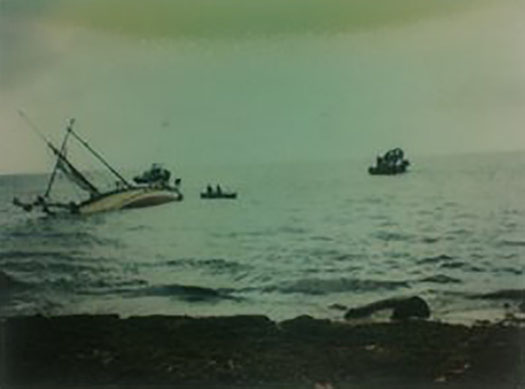
The wreck of the Saoirse in Jamaica, 1979.
Thus when the news in 1979 of Saoirse's destruction in a hurricane in Jamaica was confirmed, if anything it added to the legend. But it also meant that the only other boat created by the same team in the same place – the 56ft trading ketch Ilen (1926) – acquired added significance. But she was a long way away, still working the stormy seas around the Falkland Island, for which she'd been built after the islanders had been so impressed by the capabilities of the Saoirse, when she called there after rounding Cape Horn from the west, that they ordered a bigger sister-ship to become the inter-island workboat .
Yet thanks to a totally single-minded approach by Gary MacMahon of Limerick, Ilen was brought back to Ireland in 1998. And though it has taken quite a while for the various ideas to become reality, she is now well on the way to what has become a very public restoration with Liam Hegarty at Oldcourt Boatyard near Baltimore, while the Ilen Boatbuilding School in Limerick has become part of the fabric of Shannonside life, building not only the deckhouses and spars for Ilen herself, but an interesting selection of smaller boats ranging from traditional Shannon gandelows to the new CityOne sailing dinghies.

A man who just doesn't give up. Gary MacMahon of the Ilen School in Limerick. Photo: W M Nixon
By any standards, all these projects would be remarkable achievements in themselves. But in addition to his day job running one of Limerick's leading design studios, Gary MacMahon has for twenty years and more been quietly accumulating every bit of documentation of all sorts there is to be found relating to Saoirse.
It's an absolute treasure hoard of old photographs, certificates, plans, artefacts and other materials. And through this collecting, he has become well acquainted with Anthony Bolton who was Saoirse's last owner. Bolton had the misfortune of seeing his beloved boat destroyed by a hurricane in Jamaica before rescue attempts could save her after she'd dragged her anchor and gone ashore.
But though Saoirse was broken up by the battering of the hurricane, substantial pieces of her remained on the sea bed, and two sea-worn iron hanging knees – lovingly fitted by the Baltimore shipwrights 93 years ago – have recently been confirmed as definite relics of the wonderful little ship.
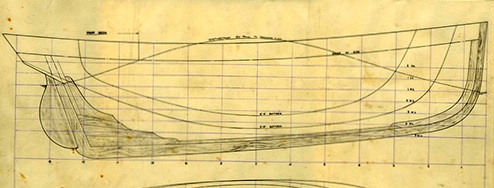
The hull lines of Saoirse as taken off by Uffa Fox in Cowes in 1927 before the start of that year's Fastnet Race (from which she retired, as endless windward work was not what she was designed for). Thanks to documentation of this quality, it will be possible to re-build Saoirse with precision. But in fact it has emerged that, such was the skill of Tom Moynihan and his boatbuilders in Baltimore in 1922-23, Saoirse as built very accurately followed the original lines drawn by O'Brien and Moynihan.

Saoirse's hull sections as recorded by Uffa Fox in 1927.
More importantly, though, the word is that much of the keel may still be intact. So just as he somehow got himself to the Falkland Islands to buy Ilen back in 1997, Gary MacMahon will shortly be going on the much easier journey to Jamaica for some real on-the-spot research as to just how much of Saoirse survives.
These days, it need only be a very small piece of the original to count as a re-build. But the spirit of the Ilen School is such that even if they find nothing at all in Jamaica, the notion of re-creating Saoirse is gaining so much traction, with that great shipwright Liam Hegarty among those totally taken with the idea of seeing Conor O'Brien's characterful little masterpiece sail again, that already the idea has acquired its own momentum.
But there'll be time enough when winter comes around again to give proper attention to the full range of Saoirse material which Gary MacMahon has amassed in order to ensure an authentic re-build. Meanwhile, this weekend may be seeing the new classic and traditional boat season kick into action in Baltimore, but already things are well under way in France, with last week's huge gathering in the Morbihan on the Biscay Coast, to which seven Dublin Bay Waterwags travelled, and eight returned.
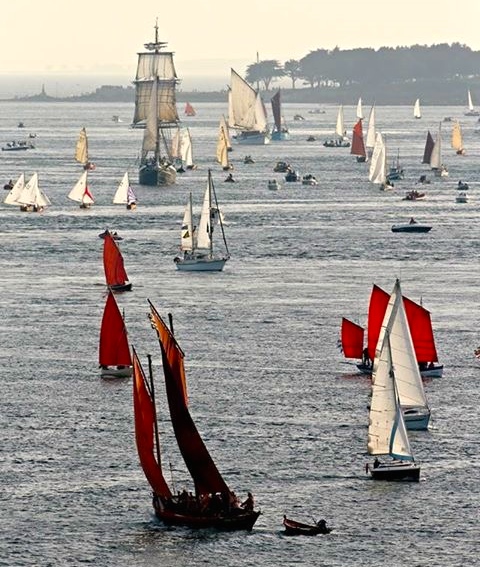
The wonders of the Morbihan. A very small part of the fleet at the Sailing Week eight days ago, with four of the Dublin Bay Water Wags at mid left. Photo: Courtesy Judith Malcolm
Like all the great French classic and tradboat festivals, the Morbihan event (it's full title is La Semaine de la Voile du Golfe de Morbihan, that's Morbihan Sailing Week in simple English) was mind-bending in terms of numbers, with 1200 boats of all shapes and sizes taking part. But the scale and layout of the Morbihan is such that it could well cope. The extensive inlet has six main ports, so the fleet was divided into six sub-groups of around 200 boats each. Everyone mingled out on the water during the day, then each night of the week-long festival saw your group going to a new port.
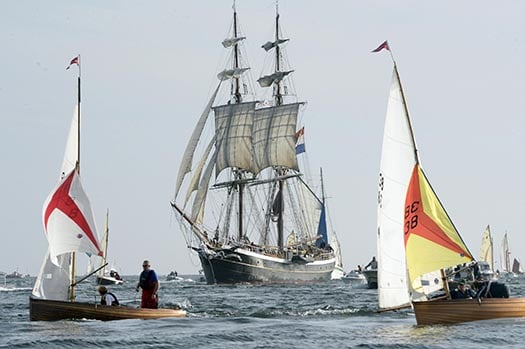
Two little Water Wags a long way from home – Ian & Judith Malcolm in the hundred year old Barbara (left) and Guy and Jackie Kilroy in Swift (right) in the midst of "sundry boats" in the Morbihan eight days ago. Photo courtesy Judith Malcolm
It worked, and it worked so well that the Irish flotilla of one Shannon One Design (Reggie Goodbody) and seven Water Wags not only had themselves a fine old time, but in a reversal of the usual story where our people return from distant places short of a boat or two, they came back with eight Wags, as Adam Winkelmann was united with his new boat. It was built in France as a boat-building academy exercise with a finish so exquisite that it was on exhibition in a marquee, but he was allowed to bring it home with him to Dublin Bay.
Far to the southwest in Baltimore, today we'll see a complex programme, as several traditional rowing craft (including a 23ft traditional Shannon cot or brochaun, the latest creation of Limerick's Ilen School built by a team headed by Tony Daly) were due to launch last night to berth at the pontoon in Skibbereen beside the West Cork Hotel. Today at 11am they start a rowing race all the way down the Ilen to Baltimore. Fortunately, the tide is ebbing.....
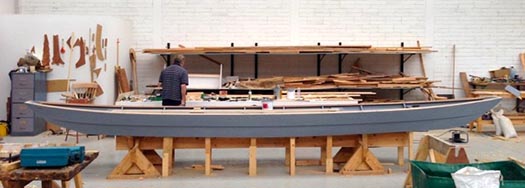
The new 23ft Shannon cot or brochaun is the latest creation of the Ilen School in Limerick. The cot's usual task was to head upriver from Limerick to fish, but today this boat will be rowed down the River Ilen from Sibbereen to the Baltimore Woodenboat Festival.
The rest of the day will see sailing and rowing races off Baltimore with a prize-giving dinner tonight in Baltimore Sailing Club presided over by Tom MacSweeney of this parish, then tomorrow (Sunday), as the one day Seafood Festival gets into full swing, there's perhaps the most interesting event of all afloat. This is the Pilot Race, in which the sailing boats put out to sea, and then turn and approach the harbour to be met by racing gigs each of which has to put a pilot on board one of the sailing craft which then race back into the harbour – it all makes for mighty sport.

Bowsprits at the ready, and the island ferry coming into port – it can only be Baltimore at Woodenboat Festival time
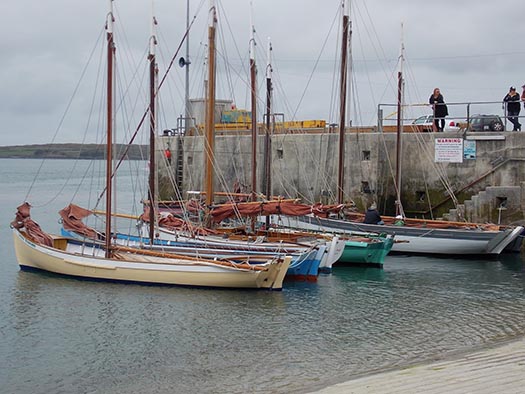
If you can identify even half of the boat types here, then you should be in Baltimore this weekend.
If your heart is with classic and traditional sailing boats, you can get an abundance of them by being in Baltimore this weekend, and then by being along Dublin's Liffey for the Riverfest in a week's time for the Bank Holiday weekend. It's a three day event (May 30th to June 1st) based on Poolbeg Y & BC, with the Old Gaffer's Leinster Trophy Race in Dublin Bay on Saturday, and then two days above the bridge for all sorts of city festivities and boat parades through to Monday evening.

The 117-year-old Howth 17s will be returning to the Dublin Riverfest in a week's time. Photo: W M Nixon
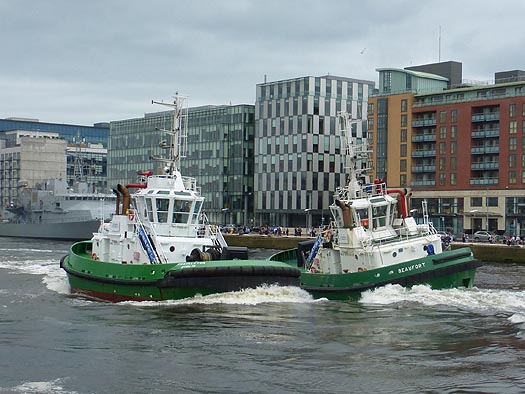
The famous waterborne ballet of the Dublin Port tugs Shackleton and Beaufort will be a main event in the Dublin Riverfest over the Bank Holiday Weekend of May 31st-June1st. Photo: W M Nixon
Following that, on Saturday 6th June out in Howth, the Classic Lambay Race is being provided within the annual Round Lambay Regatta (it dates back to 1904), with the Old Gaffers and Traditional boats joining the 117-year-old Howth Seventeens for a direct circuit from a pier start out to Lambay, round it and back again direct, with no fancy special mark rounding in between.
Defending champion in the Classic Lambay is OGA International President Sean Walsh of Dun Laoghaire with his cutter Tir na nOg, and extra interest is added this year as the fleet will include Dickie Gomes' 1912-vintage 36ft yawl Ainmara, built in Ringsend but now a longtime resident of Strangford Lough. There's a certain edge to Ainmara's involvement, as she was overall winner of the cruiser division in the 1921 Lambay Race when still owned and sailed by her designer-builder John B Kearney. But if you think this remarkable historic link will cause her opponents to give her an easy time of it, you're much mistaken.
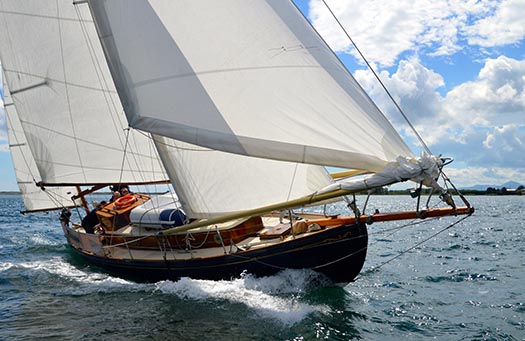
The 103-year old Ainmara – seen here on her home waters of Strangford Lough with the Mourne Mountains in the distance – will be returning to the Lambay Classic at Howth on June 6th 2015, which she last won in 1921. Photo: Pete Adams
Sean Walsh is having a busy year of it, as his duties as OGA President take him hither and yon, while Tir na nOg will be flagship for the OGA Cruise-in-Company which will follow the big one of 2015, the Glandore Classics Regatta from July 18th to 24th.
But for this weekend, he's in his home waters of Dublin Bay on a venture which means a lot to him, the OGA Youth Sailing Project at Poolbeg under the direction of Liam Begley. It's for youngsters who might not otherwise get a chance to sail. They're taken out to learn the ropes aboard two fine gaff cutters, the Clondalkin Community group's majestic Galway Bay hooker Naomh Cronan, and the OGA President's own Tir na nOg.
When we remember that many folk head from Dublin towards Cork to go sailing, it's intriguing that in this case the young people have come the other way, as they're a group from Mayfield Community School which has eternal fame through being the old school of Roy Keane.
The tyro sailors from Mayfield – there's nine of them, all in the 15-16 age group - have already become boat-acquainted through the Meitheal Mara Community Boatyard in Cork city. But the outing to Dublin puts a different spin on it all, as the first stage is devoted literally to teaching them the ropes, then after the sailing programme is completed out in the bay, the shift in skills is demonstrated by command of the two gaff cutters being given over to the Mayfield crews, who then have to sail them back to port.

OGA President Sean Walsh (top right) with Junior Gaffers from Mayfield Community School in Cork aboard Tir na nOg in Poolbeg in Dublin. Photo: John Galloway
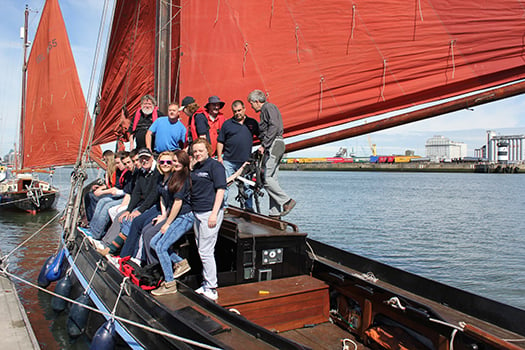
Junior Gaffers from Cork and Senior Gaffers from Dublin aboard the Naomh Cronan Photo: John Galloway
In all, it's an entertaining balance between an outing to Dublin, a chance to learn in a fun environment, and a real opportunity to demonstrate that practical skills have been well and truly acquired. And before somebody is driven to send in a rude comment after seeing these two photos of last year's Youth Sailing Project course, I hasten to assure you that when they do go sailing, everyone wears a lifejacket.
Marine Minister Forecasts Wooden Boat Building Revival
#woodenboat – Marine Minister Simon Coveney is confident that wooden boat building in Ireland is going to be revived writes Tom MacSweeney.
Traditional skills have been lost and there are fears that they will disappear forever, but the Minister sounds a confident note about preserving them on the current edition of my maritime programme, THIS ISLAND NATION.
"This project is going to reinvigorate wooden boat building in Ireland again. It is going to open a new chapter for us," he says. "Hopefully multiple ports around the country will be able to build projects like this in the future. We still have great skill sets of wooden boat building available to us in Ireland which we must not lose. It is projects like this that will keep them alive and encourage a new young generation."
I recorded Mr.Coveney at Liam Hegarty's boatyard at Oldcourt near Skibbereen where the Ilen, the last traditional sailing boat of its kind, is being restored. It is the boat which the legendary Conor O'Brien had built for the Falkland Islanders who so admired his previous vessel, Saoirse, when he sailed it into those islands during his round-the-world voyage in 1923-25. Liam Hegarty's yard at Oldcourt on a bend of the road from Skibbereen to Baltimore in West Cork is one of the few remaining that specialises in wooden boat building.
The Falklanders asked O'Brien, the first Irishman to sail a round-the-world voyage to emulate the boat on which he arrived in Port Stanley. He did as they asked, having the Ilen built in Baltimore, where Saoirse was also constructed. With two Cape Clear Islanders as crew, he sailed it to the Falklands in 1926 where it worked for 70 years until Limerickman, Gary McMahon, had it brought back to Ireland in 1997:
I was the only reporter on the quayside in Dublin when it was landed there from the deck of a cargo ship, looking every bit her age of 71 years at the time. So it was a great feeling to stand on her deck in Liam Hegarty's boatshed where the restoration work has been carried out, in conjunction with the AK Ilen boat building school, initiated by Gary McMahon, the driving force of the project Such a change from the condition in which I had seen her in the Dublin docks 18 years ago.
Gary McMahon, Liam Hegarty and Minister Coveney tell the story on the programme. Gary and Liam are both confident that Ilen will be back in the water, sailing once again. She may provide opportunities for effective sail training. Several sources have provided restoration funding. More is needed for a project which, as the Minister said, can restore Ireland's resource of traditional skills.
Also on the programme you can hear the story of a submarine which sank not once, but twice, which will make you wonder whether superstition about changing the names of boats is correct. And did you know that the Dubs beat the Kingdom ... Not in football, but fishing...?
You can hear more by listening to THIS ISLAND NATION above.
Limerick to Host New Boatbuilding Degree Courses
A new scheme to teach traditional boatbuilding skills to university level could be of huge benefit to young people from disadvantaged areas of Limerick.
The Irish Times reports that degree programmes in traditional boat craft accredited by the UK's University of Middlesex are set to take their first students in 2012.
Minister for the Marine Simon Coveney also confirmed that partnerships have been developed with the US Northwest School of Wooden Boat-building and Sail Training International.
Some 40 trainees, mostly from Limerick's designated regeneration areas, have already taken part in the restoration of the ketch Ilen, designed by record-breaking sailor Conor O'Brien.
The AKA Ilen project, set up by boat-builder Gary McMahon, is intended to "nurture self-belief and confidence through the medium of wooden boatbuilding and maritime education".
The Irish Times has more on the story HERE.



























